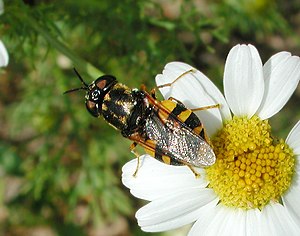Gun flying
| Gun flying | ||||||||||||
|---|---|---|---|---|---|---|---|---|---|---|---|---|

Gun fly |
||||||||||||
| Systematics | ||||||||||||
|
||||||||||||
| Scientific name | ||||||||||||
| Stratiomyidae | ||||||||||||
| Latreille , 1802 | ||||||||||||
| Subfamilies | ||||||||||||
|
The gun flies (Stratiomyidae) are a family of the two-winged (Diptera) and are assigned to the flies (Brachycera). Around 2650 species of this group are known worldwide, around 100 of them in Central Europe and 65 in Germany.
features
The name “gun flies” is derived from the coloring of the larger species of this group, which is apparently supposed to be reminiscent of old uniforms. Most species are medium in size, with some species also growing significantly larger. The size ranges from about three millimeters to 20 millimeters. Many species are markedly black and yellow, others are colored metallic. The abdomen is usually flattened and very broad and protrudes laterally over the wings folded at rest on the abdomen. Many species also have two or more thorns at the end of the chest area ( thorax ).
Way of life
Gun flies are mainly found in forest areas, mostly on different flowers. Some species, the larvae of which develop in water, are mainly found near watercourses.
The animals feed on pollen and nectar , sometimes also on organic matter from the dung of larger animals.
The females often lay their eggs one by one on the ground or on rotted plants, other species place them on the surface of bodies of water. Some species with larvae that develop in the water also lay multilayered egg packages on aquatic plants, such as the Stratiomys species.
Larval development

The larvae of the gun flies differ greatly in shape and way of life. Many species such as the Stratiomys species live in water, Oxycera larvae even in salt water . These larvae are usually spindle-shaped and the rear end is elongated into a breathing tube. At the end of this tube are the two open breathing holes, the stigmas, in the middle of a wreath of hooks. At rest, this wreath of hooks lies on the surface membrane of the water and the larva clings to it, making mostly winding movements. In the event of a disturbance, the ring of hooks collapses and the larva sinks. The larvae feed on the growth on stones or water plants.
Some species also develop in so-called phytotelmata , i.e. small collections of water in tree stumps or similar structures, as well as on rocks that have been washed over or in springs. These species have a significantly shorter breathing tube. Some species also live in the ground , in sludge or under bark, the representatives of the genus Sargus also in dung. In the terrestrial larvae, all the spiracles on the body are open, with those on the prothorax being particularly large. A breathing tube is only indicated.
The larvae of Clitellaria ephippium live as ant guests in the burrows of ants (Formicidae). Lasiopa villosa lives as leaf miners in the mullein and the larvae of the genus Pachygaster in the food aisles of bark beetles (Scolycidae), the way of life of this species is almost unheard of.
The overwintering almost always takes place as a larva. The pupation takes place in the last larval skin hardens. With Stratiomys species, this can take place horizontally on the water surface or in the bank vegetation. The adult hatches through a T-shaped gap at the front end of the doll.
Fossil evidence
Fossil weapon flies are known almost exclusively from inclusions in amber . The oldest evidence comes from Canadian amber from the Cretaceous period . The similarity between this Lower Cretaceous genus Cretaceogaster and its closest more recent relative, the genus Parhadrestia occurring in South America , is so great that both genera were placed in the newly established subfamily Parhadrestinae. The vast majority of members of this family were found in the Eocene Baltic amber . Gun flies have also been documented from other tertiary amber deposits (from Mexico and the Dominican Republic).
Systematics
According to ITIS, there are 12 subfamilies.
The following are the subfamilies with a selection of species:
- Antissinae Kertesz , 1908
- Beridinae Westwood , 1838
- Chiromyzinae Brewer , 1880
- Chrysochlorininae Woodley , 2001
- Clitellariinae Brewers , 1882
-
Hermetiinae Loew , 1862
- Soldier fly ( Hermetia illucens )
- Nemotelinae Kertesz , 1912
- Pachygastrinae Loew , 1856
- Parhadrestiinae Woodley , 1986
- Raphiocerinae Schiner , 1868
-
Sarginae Walker , 1834
- Chloromyia formosa
- Shiny green gun fly ( Microchrysa polita )
- Sargus bipunctatus
- Stratiomyinae Latreille , 1802
Individual evidence
- ↑ Rüdiger Wagner, Miroslav Barták, Art Borkent, Gregory W. Courtney, Boudewijn Goddeeris, Jean-Paul Haenni, Lloyd Knutson, Adrian Pont, Graham E. Rotheray, Rudolf Rozkošný, Bradley Sinclair, Norman Woodley, Tadeusz Zatwarnicki, Peter Zwick: Global diversity of dipteran families (Insecta Diptera) in freshwater (excluding Simulidae, Culicidae, Chironomidae, Tipulidae and Tabanidae). In: Hydrobiologia. 595, 2008, pp. 489-519. doi: 10.1007 / s10750-007-9127-9
- ^ Family Stratiomyidae. fossil Diptera
- ↑ NE Woodley: Parhadrestiinae, a new subfamily for 'Parhadrestia James' and 'Cretaceogaster Tesksy' (Diptera: Stratiomyidae) . In Syst. Entomol. II, 1986. Quoted in Poinar 1992.
- ↑ George O. Poinar, Jr .: Life in Amber. Stanford University Press, Stanford (Cal.) 1992, ISBN 0-8047-2001-0 .
- ↑ Stratiomyidae , Taxonomic Serial No. 130150, systematics at ITIS, 2002 (accessed on July 5, 2013)
literature
- J. Haupt, H. Haupt: Flies and mosquitoes - observation, way of life. Augsburg, 1998, ISBN 3-89440-278-4 .
- K. Honomichl, H. Bellmann: Biology and ecology of the insects. + CD-Rom. Gustav Fischer Verlag, Stuttgart 1994.


